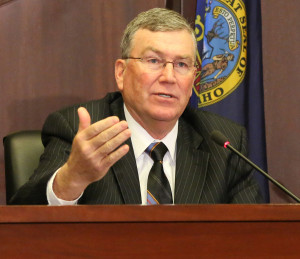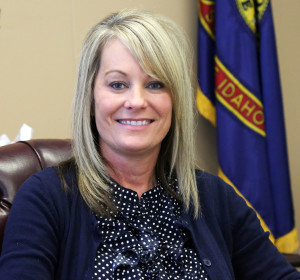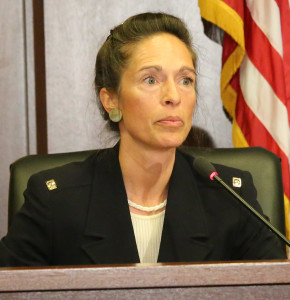Public schools represent the biggest budget on the 2016 Legislature’s to-do list.
But will this be the biggest fight of the 2016 session, which begins Monday?
Not likely.

On Thursday, House Speaker Scott Bedke said a robust K-12 budget increase “seems to be a foregone conclusion.” Two leading legislative Democrats also said the signs look encouraging.
Gov. Butch Otter isn’t divulging details, for now. At a Thursday legislative preview sponsored by the Associated Press, Otter adhered to custom and withheld hard numbers; those will come Monday, when Otter delivers his State of the State address. But he hinted at a budget that could alleviate some of the pressure on property owners, who continue to support more than $180 million a year in supplemental school levies.
The budget backdrop, by the numbers
Here are a few numbers we do know, in advance of the 2016 session:
- At nearly $1.48 billion, this year’s K-12 budget is up $101 million from 2014-15.
- With that 7.4 percent increase, the state’s public schools budget has finally hit a high water mark once again. This year’s budget exceeds the $1.42 billion appropriated in 2008 — before the Great Recession forced an unprecedented series of K-12 budget cuts.
- State superintendent Sherri Ybarra wants the 2016 Legislature to go one better. She has proposed a $110 million budget increase for 2016-17, a 7.5 percent boost.
- One piece of Ybarra’s proposal: She would put nearly $56.5 million into the second installment of the career ladder, a five-year plan to boost teacher salaries. The 2015 Legislature put $33.5 million into the launch of the career ladder.
- Another piece of the Ybarra budget: She wants to put an additional $30.6 million into school “discretionary spending,” a catchall budget that districts can use to cover salaries and benefits, transportation and utilities or other operations. Her budget would boost this spending to $25,696 per “support unit,” a classification that’s roughly equivalent to a classroom. Schools haven’t received $25,696 per support unit since 2008-09; they received $23,868 this year.
High grades from superintendents
In 2015, as a newly elected state superintendent, Ybarra came under some criticism for requesting a 6.4 percent increase in K-12 spending — less than the 7.4 percent increase requested and secured by Otter, and less than the 6.9 percent increase suggested by her predecessor, former state superintendent Tom Luna.

This year, her budget request is drawing praise from local school administrators.
In December, Idaho Education News sent an online survey to every school superintendent and charter school administrator in the state, asking about the upcoming legislative session. While only 29 administrators responded, some patterns emerged.
Asked to rate the most important education issue heading into the 2016 session, the responses weren’t surprising. Nearly every administrator focused on the budget — or, in a related vein, teacher salaries.
Ybarra’s budget recommendation received overwhelming support. For some administrators, the only question was whether the $110 million increase would go far enough.
“(I) wish it were for more,” said Sugar-Salem Superintendent Alan Dunn.
“I support her budget and applaud it, but the Legislature needs to understand that we have not had an increase for the last six years above and beyond the 2008-09 level,” said Ronald Bolinger, superintendent of the American Falls district.
Reading the tea leaves
Before Monday — when Otter unveils his 2016-17 budget request — there’s no telling how his plan will compare with Ybarra’s.
But Otter dropped a couple of broad hints about what to expect.
Speaking broadly about education funding — both K-12 and higher education — Otter said the state’s political leaders are well aware of the economic crisis that looms, if the state fails to produce a career-ready work force. Asked about Idaho’s growing supplemental school levy bill, Otter said the state might be poised to ease some of the burden on local property owners. “There might be some ideas in the pipeline.”
And another broad hint had to do with the tax structure that finances K-12, and the rest of state government. Even though legislative leaders appointed a “working group” to study Idaho’s tax code, in comparison to other states, legislators don’t seem to be in a hurry to present ideas. “I have not heard an overwhelming majority calling for tax relief this year,” Otter said.
If so, that could eliminate the tension between trying to cut taxes and trying to boost the K-12 budget.
Last year, the seven K-12 budget bills sailed through the Legislature. All seven bills passed the Senate unanimously, and passed the House with only a smattering of opposition.
On Thursday, legislative leaders all but predicted a repeat.
The question is not whether the Legislature will continue its five-year commitment to fund the recommendations of Otter’s education task force, said Bedke. The question, heading into Year Three, is whether the Legislature will move ahead of schedule.
“Can we do it all this year?” he said. “We’ll see.”

The school system was “starved” during the recession, said Senate Minority Leader Michelle Stennett. The task force’s five-year plan changed that mindset, she said.
“From all I’ve heard so far, it looks like we’re committed to continue,” Stennett said.
Later Thursday afternoon, Idaho Department of Labor Director Ken Edmunds and Division of Financial Management chief economist Derek Santos offered an optimistic economic outlook to the Legislature’s Economic Outlook and Revenue Committee at the Statehouse.
Edmunds told lawmakers he expects positive, three percent employment growth in Idaho through 2017, while Santos explained that his revenue forecast was boring, yet bullish.
“Those kinds of swings are great for rollercoasters, but not for revenue forecasting,” Santos said, referencing the steep financial decline during the Great Recession.
State revenues are important because they are the foundation that the state’s general fund is built upon and funding for K-12 public schools is the state’s largest general fund expense.
More legislative previews
- SBAC could face a test at the Statehouse
- Ybarra previews her legislative agenda
- Drop in graduation rate surprises Otter
